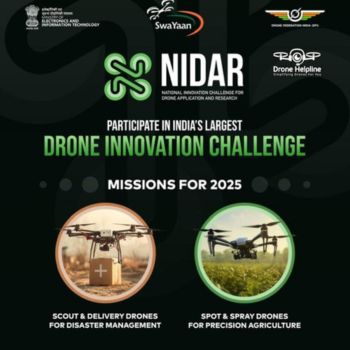MeitY and DFI under the SwaYaan Initiative is inviting submissions for National Innovation Challenge for Drone Application & Research 2025. The last date of submission is May 10.
National Innovation Challenge for Drone Application & Research (NIDAR) is India’s largest national drone innovation challenge hosted by the Ministry of Electronics and Information Technology (MeitY) and Drone Federation India (DFI) under the SwaYaan Initiative.
NIDAR motivates students and researchers from academia to build collaborative autonomous drones for solving real-world problems in disaster management and precision agriculture. With INR 40 Lakhs in prizes, startup incubation, and industry mentorship, NIDAR equips students with hands-on skills and career opportunities in India’s growing drone sector.
Mission 1 – Disaster Management:
A coastal town is flooded, affecting the entire area. Water has entered homes, forcing residents to evacuate or take shelter on rooftops without food, water, or medicines. Severe weather initially hindered relief efforts, but after 48 hours, the rain has stopped, and the wind speed has reduced. However, water levels remain high, leaving many people trapped and stranded on their rooftops. National Disaster Response Force (NDRF) and Local Administration teams are ready to start rescue efforts. Teams must build two drones to:
Each team may build one drone as a “Scout Drone” for scanning and locating survivors and another drone as a “Delivery Drone” for delivering survival kits. Teams may also consider building both drones as a combination of “Scout+Delivery Drone”. The solution strategy shall remain flexible for teams. Both drones must fly autonomously while reporting their status and mission details from a single command and control station. However, teams shall also have the option to operate both drones manually with different command and control stations by accepting a Penalty as outlined in the subsequent section of this document.
Mission 2 – Precision Agriculture:
A village was once a thriving agricultural hotspot. However, as the years passed, most residents migrated to cities for modern, high-tech job opportunities. The village now struggles with labour shortages during peak crop seasons. Furthermore, the soil quality is deteriorating due to the continuous use of pesticides in enormous quantities. It has reached alarming levels, and there is an urgent need to bring pesticide use under control. Residents have decided to adopt modern farming methods and drone technology to implement precision farming techniques. Teams must build two drones to:
Each team may build one drone as a “Scan Drone” to scan and identify stressed crops and another drone as a “Spray Drone” to spray pesticides. Teams may also consider building both drones as a combination of “Scan+Spray Drone”. The solution strategy shall remain flexible for teams. Both drones must fly autonomously while reporting their status and mission details from a single command and control station. However, teams shall also have the option to operate both drones manually with different command and control stations by accepting a Penalty as outlined in the subsequent section of this document.
NIDAR features the largest-ever cash prize pool of INR 40 Lakhs, rewarding top teams for innovation and execution. It also recognises excellence beyond drone building, offering unique awards for outstanding technology and business presentations. To further support development, five teams under each mission will receive reimbursement assistance.

